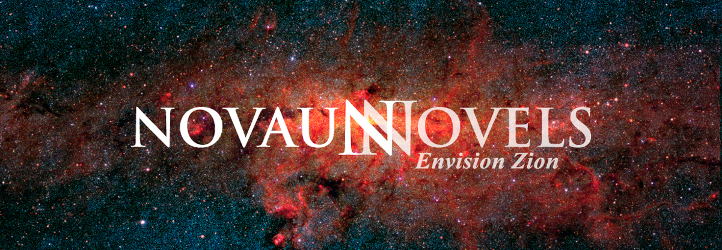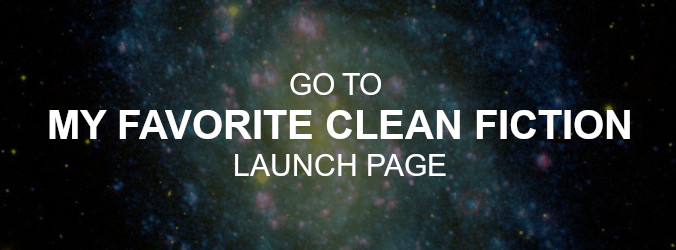Books that meet high moral standards and contain limited foul language, sexual content, and descriptions of violence.
- Before using this list, please read my disclaimer.
- Every book on this list meets “My Clean Reading Criteria” and is one that I finished, liked, and felt was worth my time to read. To learn more about the purpose of this list please see “About Novaun Novels.”
- For information on how I classify religious fiction, please see “Is Fiction Marketed to Latter-day Saints ‘Christian Fiction’?” For how I evaluate religious content in the books I read, please see “What About Doctrinal Differences?“
- All descriptions in quotation marks come from the book jackets or other descriptions from the publishers. Follow the author links to the corresponding Project Gutenberg pages. Follow the title links to the page, post, or Goodreads review that contains my commentary on the book.
Lorna Doone (English classic)
“First published in 1869, Lorna Doone is the story of John Ridd, a farmer who finds love amid the religious and social turmoil of seventeenth-century England. He is just a boy when his father is slain by the Doones, a lawless clan inhabiting wild Exmoor on the border of Somerset and Devon. Seized by curiosity and a sense of adventure, he makes his way to the valley of the Doones, where he is discovered by the beautiful Lorna.”
Don Quixote (Spanish classic)
Aging seventeenth-century Spaniard decides to become a knight-errant and sallies forth to right the wrongs of the world, in the process becoming the laughingstock of the countryside. “. . . a book that is both an immortal satire on an outdated chivalric code and a biting portrayal of an age in which nobility can be only a form of madness.”
Note: I read the English translation by Walter Starkie.
The Leatherstocking Tales (American classics)
Follow frontiersman Natty Bumppo and his Delaware comrade Chingachgook on their adventures in the American wilderness.
“Classic novel of Natty Bumppo, also known as Deerslayer, and his days as a young hunter among the Delaware Indians. A rousing story of warfare between the Indians and the white settlers around Lake Otsego before 1745.”
2. The Last of the Mohicans
“During the 1757 siege of Fort William Henry on Lake George by the French and Iroquois, two daughters of its commander set out from a neighboring fort to join their father.”
3. The Pathfinder
“Upstate New York, French and Indian War. Frontiersman Natty Bumppo, nicknamed Leatherstocking, lives near Lake Ontario. He falls in love with Mabel Dunham, a sergeant’s daughter, and wants to settle down to raise a family. Meanwhile treachery abounds among the native and European combatants.”
4. The Pioneers
“Northern New York frontier . . . Settlers in the foothills turn the wilderness into farmland and villages. Judge Temple and his daughter, Elizabeth, help to establish a new civilization, while the natives and frontiersmen are driven out. Old hunter Natty Bumppo, called Leatherstocking, observes the changing environment with regret.”
5. The Prairie
“Early 1800s. Civilization drives old hunter Natty Bumppo (Leatherstocking) west of the Mississippi to the prairies, where he becomes a trapper and helps a band of emigrants in their conflicts with Indians, miscreants, and the harsh environment. “
The Count of Monte Cristo (French classic)
“Thrown in prison for a crime he has not committed, Edmond Dantès is confined to the grim fortress of If. There he learns of a great hoard of treasure hidden on the Isle of Monte Cristo and he becomes determined not only to escape, but also to unearth the treasure and use it to plot the destruction of the three men responsible for his incarceration.”
Note: I read the Bantam Classics edition, translated into English and abridged by Lowell Blair.
The Man in the Iron Mask (French classic)
“France in the 1660s is a boiling cauldron of plots and counter-plots as King Louis XIV struggles to extend his power and transform himself into the ‘Sun King.’ Locked within the dreaded Bastille prison may be his enemies’ ultimate weapon: an anonymous prisoner forced to wear an iron mask so that none may see his face—and learn his astonishing secret.”
Note: I don’t know what English translation I read.
The Call of the Wild (American classic)
“Stolen from his comfortable life in California, Buck is sold into service as a sled dog during the Klondike Gold Rush, where returning to his primordial nature is the only way for him to survive.”
The Sea Wolf (American classic)
“Powerful and gripping saga of Humphrey Van Weyden, captured by a seal-hunting ship and now an unwilling sailor under its dreaded captain, Wolf Larsen. The men who sailed with Larsen were treacherous outcasts, but the captain himself was the legendary Sea Wolf—a violent brute of a man.”
White Fang (American classic)
“Wronged by human and beast alike, White Fang has endured through brazen ferocity. An enemy of his kind, he is sold to a dogfighter who pits him against other canines to the death—until a Yukon gold hunter comes to his rescue and provides an opportunity for a new life.”
Murray, Stuart
Judith’s Dime Novel (western)
“Crossing the Sierra Nevada by stagecoach in 1868, Judith Adams brings along all her Eastern illusions about the Wild West—illusions borrowed from the romantic dime-novel Westerns she loves to read. . . . When the stagecoach is ambushed, Judith’s life suddenly seems to come right out of the dog-eared pages of her favorite dime novel.”
White Fire (historical adventure)
“Frontier adventurers in southern Africa battle a secret occult brotherhood and native conspirators for possession of an ancient amulet that has the power to reveal great treasures or to destroy its bearer.”
The Scarlet Pimpernel (English classic)
“Armed with only his wits and his cunning, one man recklessly defies the French revolutionaries and rescues scores of innocent men, women, and children from the deadly guillotine. His friends and foes know him only as the Scarlet Pimpernel. But the ruthless French agent Chauvelin is sworn to discover his identity and to hunt him down.”
The Elusive Pimpernel (English classic)
“In this thrilling sequel, the terrorist Chauvelin devises a vile plot to eliminate the Pimpernel . . . once and for all.”
El Dorado (English classic)
“The still-raging French Revolution continues to claim lives, and the shadow of the guillotine draws ever nearer to the young Dauphin, son of Louis XVI and Marie Antoinette. No one dares to attempt to liberate the little prince—no one, that is, but the . . . Scarlet Pimpernel.”
Richardson, Boyd
Voices in the Wind (Christian western, Latter-day Saint)
“Billy Brigham (Walking Short), a full-blooded Shoshone Indian, was raised by a Shoshone tribe, then adopted by a prominent Mormon family. He does not feel fully accepted in either world, yet honors the good in both. When he rescues the Brisk family he faces the rage of outlaws, the anger of his own people, and the sting of racial prejudice.”
Scaramouche (Italian-English classic)
“Once he was André-Louis Moreau, a lawyer raised by nobility, unconcerned with the growing discontent among France’s lower class—until his friend was mercilessly struck down by a member of the aristocracy. Now he is Scaramouche. Speaking out against the unjust French government, he takes refuge with a nomadic band of actors and assumes the role of the clown Scaramouche—a comic figure with a very serious message.”
Ivanhoe (Scottish classic)
“Published in 1819 and set at the close of the 12th century, this classic historical romance unfolds in a kingdom torn asunder by the hatred between Saxons and Normans. Its dispossessed heroes, Ivanhoe and Richard the Lion-Hearted, face an uphill battle against firmly entrenched adversaries. The success of their fight rests upon the support of an unlikely crew of outsiders, including a Jew accused of sorcery, a swineherd slave, a jester, and the legendary Robin Hood.”
Kenilworth (Scottish classic)
“In the court of Elizabeth I, Robert Dudley, Earl of Leicester, is favoured above all the noblemen of England. It is rumoured that the Queen may chose him for her husband, but Leicester has secretly married the beautiful Amy Robsart. Fearing ruin if this were known, he keeps his lovely young wife a virtual prisoner in an old country house. Meanwhile Leicester’s manservant Varney has sinister designs on Amy, and enlists an alchemist to help him further his evil ambitions.”
The Black Arrow (Scottish classic)
“Young Dick Shelton, caught in the midst of England’s War of the Roses, finds his loyalties torn between the guardian who will ultimately betray him and the leader of a secret fellowship, The Black Arrow. As Shelton is drawn deeper into this conspiracy, he must distinguish friend from foe and confront war, shipwreck, revenge, murder, and forbidden love, as England’s crown threatens to topple around him.”
Twain, Mark (pen name of Samuel Clemens)
The Adventures of Huckleberry Finn (American classic)
“When Huck escapes from his drunken father and the ‘sivilizing’ Widow Douglas with the runaway slave Jim, he embarks on a series of adventures that draw him to feuding families and the trickery of the unscrupulous ‘Duke’ and ‘Daupin’.”
The Adventures of Tom Sawyer (American classic)
“Perhaps the best-loved nineteenth-century American novel, Mark Twain’s tale of boyhood adventure overflows with comedy, warmth, and slapstick energy. It brings to life and array of irresistible characters—the awesomely self-confident Tom, his best buddy Huck Finn, indulgent Aunt Polly, and the lovely, beguiling Becky—as well as such unforgettable incidents as whitewashing a fence, swearing an oath in blood, and getting lost in a dark and labyrinthine cave.”
Personal Recollections of Joan of Arc (American classic)
“This historical novel chronicles the French heroine’s life, as purportedly told by her longtime friend—Sieur Louis de Conté. A panorama of stirring scenes recount Joan’s childhood in Domremy, the story of her voices, the fight for Orleans, the splendid march to Rheims, and much more.”
The Prince and the Pauper (American classic)
“This treasured historical satire, played out in two very different socioeconomic worlds of 16th-century England, centers around the lives of two boys born in London on the same day: Edward, Prince of Wales and Tom Canty, a street beggar. During a chance encounter, the two realize they are identical and, as a lark, decide to exchange clothes and roles—a situation that briefly, but drastically, alters the lives of both youngsters.”
The Virginian (American classic)
“Still as exciting and meaningful as when it was written in 1902, Owen Wister’s epic tale of one man’s journey into the untamed territory of Wyoming, where he is caught between his love for a woman and his quest for justice, has exemplified one of the most significant and enduring themes in all of American culture. With remarkable character depth and vivid descriptive passages, The Virginian stands not only as the first great novel of American Western literature, but as a testament to the eternal struggle between good and evil in humanity, and a revealing study of the forces that guide the combatants on both sides.”
The featured image “Florida Forest” is Copyright © 2022 by Katherine Padilla. All rights reserved.




